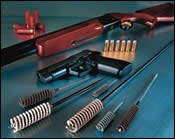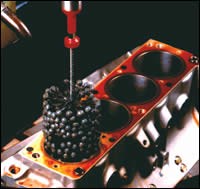Choosing and Using Ball-Style Hones
Many applications require custom tools
For engineers in the automotive, aerospace, manufacturing and machining industries, the ball-style hone is a highly specialized abrasive tool that is instantly recognizable by its unique appearance. Characterized by the small, abrasive globules that are permanently mounted to flexible filaments, the product is a flexible, low cost tool used for sophisticated surfacing, de-burring and edge-blending.
Flexible honing is a method of developing a surface on a metal part that is smooth and metallurgically free of any fragmented, amorphous or smeared metal from previous operations, resulting in the reduction of localized heat and friction. The ball-style hone accomplishes this using a low-temperature, low-pressure abrading process that exposes the undisturbed base metal structure to produce a long-wearing surface.
Ball-style hones were originally developed as an improvement for the finish produced by rigid stone hones commonly used in engine cylinder sizing. Mass production methods in the past normally consisted of boring, then finishing to size using a rigid hone. The cylinder bore finish then had to be abraded down by piston rings in what was known as the seating-in or breaking-in process. By the time the microscopic peaks had been worn off the cylinder wall, one had an engine or a hydraulic cylinder that was much less efficient than if the cylinder and rings had a plateaued finish to begin with.
Being resilient, self-centering, self-aligning to the bore, and self-compensating for wear, the ball-style hone has become the solution for creating a plateaued finish with minimal breaking-in, allowing for improved lubrication and reduced machine wear. Since their development for the automotive industry, ball-style honing tools have been found to be useful in numerous other industries and applications and have become widely adapted.
Bore Finishing
While many of the available tools share fundamental characteristics, there is a significant quality difference between a generic offering and a custom-adapted honing tool engineered to meet the highly specialized requirements of the applications in which they are deployed.
The problem is, no two plateauing applications are alike. Frequently the bore is either too smooth or too rough. Ball-honing will eliminate such problems so long as the tool is adjusted to meet the requirement of the individual application.
For example, as discussed above the goal of plateauing in engine manufacturing is to remove loose, cut, torn and folded material within the cylinder, create valleys and remove peaks that would otherwise damage rings or seals. An imperfect finish within a cylinder causes undue wear on rings and seals as they ride, and can also cause scuffing (a condition of metal transfer between the piston ring and the cylinder wall) leading to engine failure. The result of precision plateauing is smooth operation of the piston rings in the cylinder, more lubricant retention, improved engine startup and performance, and longer life of the engine.
Brush Research Manufacturing Co., Inc. (BRM), a privately held industrial brush manufacturer located in Los Angeles, originally developed the patented Flex-Hone ball-style hone for cylinder finishing and deburring applications. Since then, BRM has continued its abrasive technology research and developed a full line of additional industrial abrasive products, such as power and miniature brushes and twisted-in-wire tools.
The Flex-Hone tool’s unique design makes it ideal not only for its intended purpose—bore finishing—but for a variety of applications that call for a resilient, flexible and soft-cutting honing solution. The tool’s independently suspended abrasive globules both self-center and self-align to the bore and compensate for wear, which facilitates close-tolerance finishing work.
Variety of Applications
The applications for which ball-style hones are suitable include golf club hosel hole finishing, finishing of firearm firing chambers and shotgun barrels and finishing musical instruments as well as more complex jobs.
A typical application involves Humphrey Products, a manufacturer of pneumatic components in Kalamazoo, MI. The company was having a problem deburring the inside hole of a valve part, experiencing an unacceptable 5% loss in parts for every run. Compete deburring was essential to smooth operation of the finished valve, and the process was being performed with steel media. A switch to the Flex-Hone minimized scrap and is now a permanent part of Humphreys’ manufacturing process.
Another company, Haskel Inc. (Burbank, CA), uses Flex-Hone tools to remove burrs from holes drilled in the air cycling sleeve of an air-driven pump. Burrs remaining within these holes can cause major damage to the completed unit, so their removal is vital. In the past, Haskel would send the sleeves to an outside vendor for costly and time-consuming manual deburring. Finished sleeves were then brought back to Haskel for assembly. Implementing the Flex-Hone and bringing the deburring process back in-house resulted in a 40% cost savings versus the out-sourced manual deburring process.
Tool Selection
Picking the right hone for your application is no simple matter. This type of honing tool should not be viewed as a commodity, but as an instrument crafted to yield maximum value in a specified application. Important selection factors include the size of the tool, the type of abrasive used and the grit/grade.
Honing tools from BRM are available in sizes to finish bore diameters from 4 mm to 36 in. Available abrasive types include silicon carbide, aluminum oxide, boron carbide, tungsten carbide, levigated alumina and zirconia-alumina. All abrasives are produced in a range of grit sizes, from very coarse (20) to as fine as 800. Tools can be easily customized for tapered and multi-diameter bores. Potential users can send us a part for evaluation, and include bore inside diameter, the base material being finished, the existing finish parameters and the desired finish parameters.
Cylinder Bore Finishing
Total Seal Inc. is a Phoenix-based manufacturer of performance piston rings. The company’s products are subjected to rigorous testing, a process partly involving cylinder ball-honing.
According to Jones, the object in honing is to achieve a prescribed set of roughness/finish numbers, and for this purpose the use of the right abrasive and grit size are essential. A failure to employ both in the case of engine cylinder wall finishing can affect engine operation, because pistons may not seat correctly if the cylinder bore surface is too rough, too smooth or out of the recommend microfinish range.
An additional goal of cylinder honing is creation of a 45° cross-hatched pattern on the cylinder wall. The cross-hatching facilitates distribution of the lubricant during engine operation, allowing it to evenly coat the entire wall. An imprecise honing method can create either an uneven or unidirectional cross-hatch, which will cause rings to rotate or surge in the direction of the groove. This in turn causes undue wear on rings and on the piston wall.
A ball hone, because it is self-centering, cuts evenly in both directions to create a uniform 45° cross-hatch. The resulting pattern not only results in savings in engine wear and lubricant, but it also affects the environment, lowering blow-by into the oil crankcase and the atmosphere.
Jones says his customers are all involved in motor sports and have stringent tooling requirements. Racing engines must be in top running order at all times, and a good seal between rings and the cylinder wall is a requirement. “For that the ball hone generally does an exceptional job. It’s a very user-friendly product,” he concludes.
More Applications
Another BRM customer, Copeland Corp. (Sidney, OH), produces motor compressors and condensing units in capacities from 1/4 to 100 hp. The company manufactures 750,000 compressors per year, and maintains very rigid standards for component cleaning and deburring. Contaminants such as cast iron dust, chips and burrs, if loose in an assembled compressor, can cause the unit to fail. Deburring is particularly critical, because a burr is raised on each compressor’s head deck at the cylinder at the time the cylinder is bored. The compressors range from one cylinder up to nine in tandem units.
Copeland uses the Flex-Hone for deburring by placing the hone in a hand-held air tool and securing it with a standard key chuck. By adopting the ball-style hone for deburring, the company avoided either of two costly options: re-tooling its 30 boring heads for deburring at a cost of $1000 to $2000 each; or implementing manual deburring, which would add 25 minutes of labor time per unit and increase labor costs by more than $50,000. The company says the ball-style deburring tools allowed them to maintain high-quality standards at minimal cost.
Miller Industrial Products Inc. (Jackson MI) specializes in machining of disc brake rotors and brake drums for cars and trucks. According to president/general manager Bill Miller, the flexibility of ball-style hones makes them adaptable to entirely new applications.
For example, his shop uses custom Flex-Hone tools to resurface the inside of auto brake drums. Creating a non-directional surface finish limits “brake hum,” which can be very annoying to motorists, Miller explains.
Surfacing was previous accomplished by grinding, a long and tedious job. BRM worked with Miller Industrial to engineer a hone large enough to perform this task painlessly.
Since that time, Miller has also adapted the technology to do finishing work on brake rotors as well. The company operates several machines fitted with ball-style hones, a conversion facilitating the processing of thousands of disc brake rotors per day.
Miller foresees even more applications for ball-style hones in the future. “The automotive industry runs on quick turnaround, and there’s no time to go out and buy equipment every time a new requirement comes up,” he says. “We can call Brush Research and get a specialized solution custom-built in very short order. We’ve actually built machinery around their hones. That’s how much we’ve come to depend on the tool.”
Read Next
Delivering Increased Benefits to Greenhouse Films
Baystar's Borstar technology is helping customers deliver better, more reliable production methods to greenhouse agriculture.
Read MoreA ‘Clean’ Agenda Offers Unique Presentations in Chicago
The 2024 Parts Cleaning Conference, co-located with the International Manufacturing Technology Show, includes presentations by several speakers who are new to the conference and topics that have not been covered in past editions of this event.
Read MoreEducation Bringing Cleaning to Machining
Debuting new speakers and cleaning technology content during this half-day workshop co-located with IMTS 2024.
Read More

















.jpg;maxWidth=300;quality=90)




